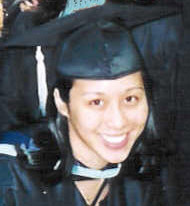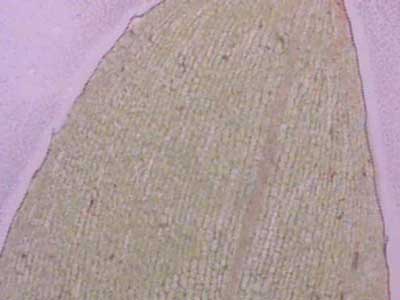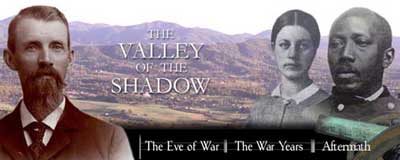Technology integration in the Curry School’s teacher education program has been a 15-year effort, initiated and supported by the school’s leadership, spurred on by technology innovators, and adopted by many mainstream education faculty members who have discovered technology’s discipline-specific benefits for teaching and learning.
The following vignette describes the path of one student through the Curry School teacher education program. No one student could be said to be typical, but this overview provides a window into many of the technology-related activities a student might experience. A broader picture of the teacher education program and its philosophy of technology integration follows this vignette.
Emily’s Experience in the Curry School of Education

Figure 1. Emily
Emily, a recent graduate of the science education program (Figure 1), has long possessed a keen interest in science, as evidenced by her choice to earn an advanced studies diploma from Thomas Jefferson High School for Science and Technology. She then did an internship with the Division of Virus Diseases at the Walter Reed Army Institute of Research and a research internship with the Southern Ocean Global Ocean Ecosystems Dynamics Program on the West Antarctic Peninsula.
In fall 1996, Emily entered Curry School’s five-year teacher education program, in which she would ultimately earn two degrees: a bachelor of arts in biology from the University of Virginia’s College of Arts and Sciences and a master of teaching and professional licensure from the Curry School in the subject area of secondary science (BA/MT). Her first two years in the program, she focused on professional training in subject matter specialties, such as cell biology, organic chemistry, genetics, and vertebrate zoology.
College of Arts and Sciences and Curry School requirements interfaced throughout her program. Her formal introduction to the field of education occurred in her second year, when Emily completed the course EDIS 201/288: Teaching as a Profession/Field Experience. This course, which is required for all BA/MT students, includes field-based experiences and helps students discern whether teaching is right for them. Four weeks of the field experience portion of the course is dedicated to technology. Teacher education students explore different facets of educational technology, including instructional, pedagogical, and ethical issues and concerns. Students leave the course with a baseline set of skills, the beginnings of a philosophy of technology in education, and an understanding of appropriate use of technology in schools.
In year 3 of her program Emily took another required course integrating technology EDLF 345: Introduction to Teaching and Learning With Technology, Mathematics/Science Section. This course marked a shift in her technology training from facilitating information management with generic skills to enhancing the teaching of science content. The technologies she learned in this course were all specifically applicable to science and/or mathematics teaching and were all demonstrated in the context of learning science or mathematics content. For example, she learned more about online databases and spreadsheet software while researching the El Nino weather phenomenon (Figure 2; see Bell, Niess, & Bell, 2001). She experienced the power of computer simulations while increasing her own understanding of solar system dynamics. Other content-based activities integrated graphing calculators, probeware, and multimedia PowerPoint presentations.

Figure 2. Screen capture from the National & Regional Climate Center’s website (http://www.wrcc.dri.edu/rcc.html).
Year 4 of Emily’s program narrowed her focus on teacher preparation. In EDIS 550, the science methods course, Professor Randy Bell used technology regularly as a tool to demonstrate teaching strategies that encourage inductive and inquiry-based instruction. Emily worked with digital microscopes, robotic telescopes, virtual planetarium software, spreadsheets, graphing calculators, web sites, and digital cameras. Despite the number and range of technology tools used in the course, the focus was not on the technology itself, but on how it can enhance conceptual understanding of science topics (see Flick & Bell, 2000).
Early in the fall semester Emily and her classmates began preparing to present at the Virginia Association of Science Teachers annual conference in November. These preservice teachers developed their own activities and demonstrated the IntelPlay QX3 digital microscope (Figure 3) to the 1,000 in-service teachers in attendance at the conference (see Bell & Bell, 2002). Many experienced teachers do not feel comfortable using technology in their instruction, partly because they have never had the opportunity to develop a vision of instructional technology in the context of science teaching. Emily and her preservice teacher cohort had this vision and could confidently share it with more experienced teachers. Afterwards, Emily wrote in a summary report that she was grateful to attend an event that gave her a feeling of community with science educators, as well as with her peers: “Being in an environment surrounded by other teachers gave me the feeling that what I was doing was important.”

Figure 3. The Intel QX3 Digital Microscope.
During both semesters of the science methods class, Emily and her fellow preservice teachers also collected teaching resources (see resource card examples ) from printed and online materials, which they shared electronically with the entire class. The assignment required that 20% of their resource cards integrate technology.
In fall 2001, Emily began student teaching at a northern Virginia high school. In the early stages of her student teaching, during an introductory unit on Tools of the Biologist, Emily used interactive web sites displayed on a large screen monitor in her classroom to show her students images produced by a scanning electron microscope.
As Emily became more comfortable with teaching and technology use, she put the technology in the students’ hands. Emily introduced her students to the IntelPlay QX3 digital microscope by having them make observations of common objects (like a penny). In her unit on cell structure, she provided prepared slides of leaf cells for students to photograph and label using the digital microscope. Then, students learned to prepare their own slides of cheek cells and elodea. Students captured images of the cells, labeled cell parts, and then printed the images to include in their laboratory reports.

Figure 4. Elodea cell image from the QX3 microscope.
Emily also experimented with PowerPoint presentations during her unit on chemistry, with an engaging video of the Hindenburg disaster. During field work on an environmental biodiversity project, Emily, her mentor teacher, and their students used digital cameras to document the trees in an area near their school and then entered the data on a spreadsheet for future reference.
Throughout the Curry School’s secondary science education program, Emily had opportunities to learn technology skills and see technology use modeled in authentic ways that enhanced conceptual understanding in science. External motivations in the form of course requirements ensured that Emily reflected on the effectiveness of appropriate technology use. During her student teaching experience, Emily then demonstrated what she had internalized about technology use (as well as about other important areas such as nature of science instruction and inquiry-based approaches). As a matter of fact, classroom observations and interviews revealed that all of Emily’s classmates integrated technology at some level in their student teaching experiences (Bell & Tai, in press).
The science education program described in the vignette is not unique in the Curry School. Stories just as compelling can be told about the other teacher education program areas, as well (see http://www.teacherlink.org/resources/index.htm for additional course syllabi and student work samples). Faculty members in each content area emphasize technology in ways that best fit their discipline.
The Curry School’s Commitment to Technology Integration
In 1984 the Curry School of Education reorganized both the education school and its associated teacher education program, designating educational technology as one of three strands (along with special education and multicultural education) to be integrated throughout the program. The Curry School dean, Jim Cooper, recognized that information technology would play an increasingly central role in both industry and society and, hence, would be relevant to the next generation of K-12 students. He endorsed a mandate to prepare Curry graduates to become technology leaders in the school systems they entered after graduation. This commitment to technology leadership has continued through the terms of two subsequent deans and is designed to encourage and support faculty members as they integrate technology in their teaching and research.
As a result Curry School faculty members have collaborated with a number of educational and corporate partners to develop an infrastructure to support this effort over the past 25 years. Throughout the 1980s before widespread use of the Internet the teacher education program worked with IBM to develop a wide-area network (Teacher-LINK) to connect student teachers, their supervising teachers, and university faculty. In the 1990s the Virginia Department of Education collaborated with the University of Virginia to extend this network to all 2,000 schools in Virginiathe nation’s first statewide K-12 Internet system. The Curry School subsequently has pioneered the use of videoconferencing in telecollaborative classes and seminars.
The dean’s office established the Instructional Resources Center, now the Educational Technology Center, to provide technology support to the academic and research endeavors of all Curry faculty, staff, and students. The Center, which continues to evolve, includes help desk staff who provide troubleshooting assistance and general computing information, as well as routing requests for technical and repair services. The Faculty Development Center, complete with audiovisual equipment and help staff, also provides instructional support.
The Ultimate Goal: Effective Teacher Preparation
The ultimate goal of this technology infrastructure support has been more effective teacher preparation. Over time, teacher education faculty members have identified ways to incorporate technology into their content areas, especially in the secondary program. Some faculty members use technology as a medium for delivering instruction, as in Bob McNergney’s CaseNET course. CaseNET (or CaseNEX in its commercial form) is an elective course available to preservice teachers via the Internet (World Wide Web, video conference, discussion groups, and electronic mail), videotape, and print materials. Other faculty members use technology as a management tool to facilitate sharing of ideas. For example, Margo Figgins’ course for English education majors includes Q-folio (nmc.itc.virginia.edu/q-folio), an electronic, interactive community that supports the research and composing processes of her English education students (Young & Figgins, 2002)
Still others are focusing on using technology as a catalyst to reconceptualize the content area. Science education assistant professor Randy Bell has explored many technologies that allow students to learn content in ways they could not before, with a focus on developing more accurate conceptual understandings. For example, from prior science courses most science education students have developed some rudimentary conceptions of the Doppler effect (a phenomenon of waves). Their understanding of this phenomenon is often superficial, due to the way they were taught this abstract concept. In the science methods course, preservice teachers learn how the online sound wave simulation applet at www.explorescience.com can help them visualize waves emanating from an object at rest, traveling slower than the speed of sound, at the speed of sound, and greater than the speed of sound (Figure 6). The result is a more complete conceptualization of the Doppler effect and greater motivation through their participation in an interactive, inquiry-based activity. (For other similar science activities using technology, see http://www.teacherlink.org/content/science/instructional/ .)

Figure 5. Screen capture from the Doppler effect activity on www.explorescience.com.
In secondary social studies methods class, students are introduced to ways technology facilitates constructivist pedagogy and social studies instruction (Mason et al., 2000). Assistant professor Stephanie Van Hover has students review web quests and assess them, using what they have learned about teaching and learning history/geography (i.e., do they encourage higher order thinking, encourage historical inquiry, incorporate primary and secondary sources?). Students explore other Internet tools, discussing different software (like Cartopedia) and ways to determine their instructional usefulness. They cover how to make the most of a one-computer classroom and ways to use the computer lab for meaningful activities. They also explore digital resources for primary sources, such as the Center for Technology and Teacher Education web site (www.teacherlink.org/content/social/), the Virginia Center for Digital History (www.vcdh.virginia.edu/, Figure 6), the national archives, and the Library of Congress.

Figure 6. Screen capture from The Valley of the Shadow, from the Virginia Center for Digital History website (www.vcdh.virginia.edu
Potential uses of innovative technologies in education are explored both through the teacher education program and through partnerships with local K-12 schools. Mathematics education associate professor Joe Garofalo, for example, has been integrating technology in the mathematics education program for a decade. In his mathematics methods courses he models teaching with graphing calculators, spreadsheets, and the popular computer software Geometer’s Sketchpad. He and his doctoral students have developed a number of activities utilizing these technologies (Figure 7), which they use not only when teaching preservice teachers but also when presenting in-service teacher professional development (see http://www.teacherlink.org/content/math/). Professor Garofalo’s primary goal is for teachers to understand how to teach using technology appropriately (see Garofalo, Drier, Harper, Timmerman, & Shockey, 2000), whether or not they use the specific activities he has developed. However, many teachers are able to adapt to their curriculum some of the technologies and activities Professor Garofalo and his graduate students have modeled. They use feedback from both veteran and preservice teachers to inform the way they introduce and extend technology-enhanced mathematics activities. Where these technologies show promise, they are subsequently disseminated through publications and national policy partnerships.

Figure 7. Screen capture from www.ExploreMath.com. See Harper, Schirack, Stohl, & Garofalo (2001) for descriptions of this and other mathematics activities.
Curry School faculty members have also participated in development of state and national technology standards for teachers and teacher education programs and continue to collaborate with corporate technology developers, other teacher education programs, and national teacher educator associations. For several years, a group of Curry faculty members in teacher education and in related areas (i.e., instructional technology, evaluation, and policy studies) worked together to develop and assess technology’s potential in education. This informal cross-disciplinary collaboration was formalized in the mid-nineties through establishment of the Curry Center for Technology and Teacher Education (www.teacherlink.org/), created with the following mission:
- To develop and identify appropriate uses of technology in teacher education.
- To develop educational software and materials that help teacher educators and K-12 teachers enhance their teaching in the content areas.
- To prepare the next generation of educational technology leaders.
- To contribute to the formation of educational technology policy.
Center faculty members and graduate fellows currently teach some of the content area methods courses (in which technology use is modeled), as well as many of the technology-focused courses for preservice teachers in the Curry School.
Conclusion
The emphasis on technology integration initiated by Curry School leadership over 15 years ago pre-dates the NETS-T standards (International Society for Technology in Education, 2000), yet this emphasis has resulted in an approach to schoolwide technology integration that is entirely consistent with the spirit of the standards. The Curry School has the usual mix of “innovators,” “mainstreamers,” and “laggards” among its teacher education faculty. However, the school has recognized that authentic technology integration is a decades-long process. Rather than forcing generic technologies on reluctant users, the school’s approach has been to encourage and support faculty in exploring technology’s benefits at their own pace in their own specialty areas. As a result, teacher education students have multiple opportunities not only to learn basic productivity and communication skills but to experience technology’s potential to enhance content-specific conceptual learning.
The long-term commitment to technology integration maintained by Curry School leadership over two decades continues to guide the teacher education program to successfully produce innovative teachers who are prepared to be technology leaders.
References
Bell, R. L., & Bell, L. (2002). Invigorating science teaching with a high-tech, low-cost tool. Edutopia: The George Lucas Educational Foundation Bulletin. [Online serial]. Available at: http://glef.org/techtoolarticle.html
Bell, R. L., Niess, M. L., & Bell, L.L. (2001). El Niño did it: Using technology to assess and predict climate trends. Learning and Leading With Technology, 29, 18-26.
Bell, R.L., & Tai, R. (in press). Transforming science instruction with technology. In Sheekey, A. D. (Ed.), Conditions for successfully implementing and integrating educational technology. Alexandria, VA: Appalachian Technology in Education Consortium.
Flick, L., & Bell, R. (2000). Preparing tomorrow’s science teachers to use technology: Guidelines for Science educators. Contemporary Issues in Technology and Teacher Education [Online serial], 1 (1). Available: https://citejournal.org/vol1/iss1/currentissues/science/article1.htm
Garofalo, J., Drier, H., Harper, S., Timmerman, M.A., & Shockey, T. (2000). Promoting appropriate uses of technology in mathematics teacher preparation. Contemporary Issues in Technology and Teacher Education [Online serial], 1 (1). Available: https://citejournal.org/vol1/iss1/currentissues/mathematics/article1.htm
Harper, S.R., Schirack, S.O., Stohl, H.D., & Garofalo, J. (2001). Learning mathematics and developing pedagogy with technology: A reply to Browning and Klepsis. Contemporary Issues in Technology and Teacher Education, [Online serial] , 1 (3) . Available: https://citejournal.org/vol1/iss3/currentissues/mathematics/article1.htm
International Society for Technology in Education. (2000). National educational technology standards for teachers. Eugene, OR: Author.
Mason, C., Berson, M., Diem, R., Hicks, D., Lee, J., & Dralle, T. (2000). Guidelines for using technology to prepare social studies teachers. Contemporary Issues in Technology and Teacher Education [Online serial], 1 (1). Available: https://citejournal.org/vol1/iss1/currentissues/socialstudies/article1.htm
Young, C. A. & Figgins, M. A. (2002). The Q-folio in action: Using a web-based electronic portfolio to reinvent traditional notions of inquiry, research, and portfolios. Contemporary Issues in Technology and Teacher Education [Online serial], 2(2). Available: https://citejournal.org/vol2/iss2/english/article1.cfm
Contact Information:
Randy Bell ([email protected]) and Mark Hofer
Curry School of Education PO Box 400279
University of Virginia
Charlottesville, VA, USA
![]()